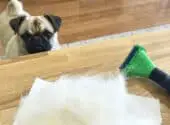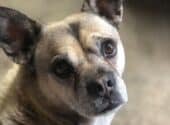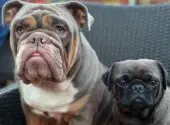If you are frustrated by the excessive vacuuming and removal of large clumps of fur and dreading that your dark clothes may be covered in your Husky’s shedding within minutes, you must take action. It is time to end this dilemma once and for all.
In this how-to guide, we’ve compiled the nine best ways to stop husky shedding ASAP. From proper grooming techniques to dietary changes, we’ll cover everything you need to know for a happier, healthier, less shedding furry pal.
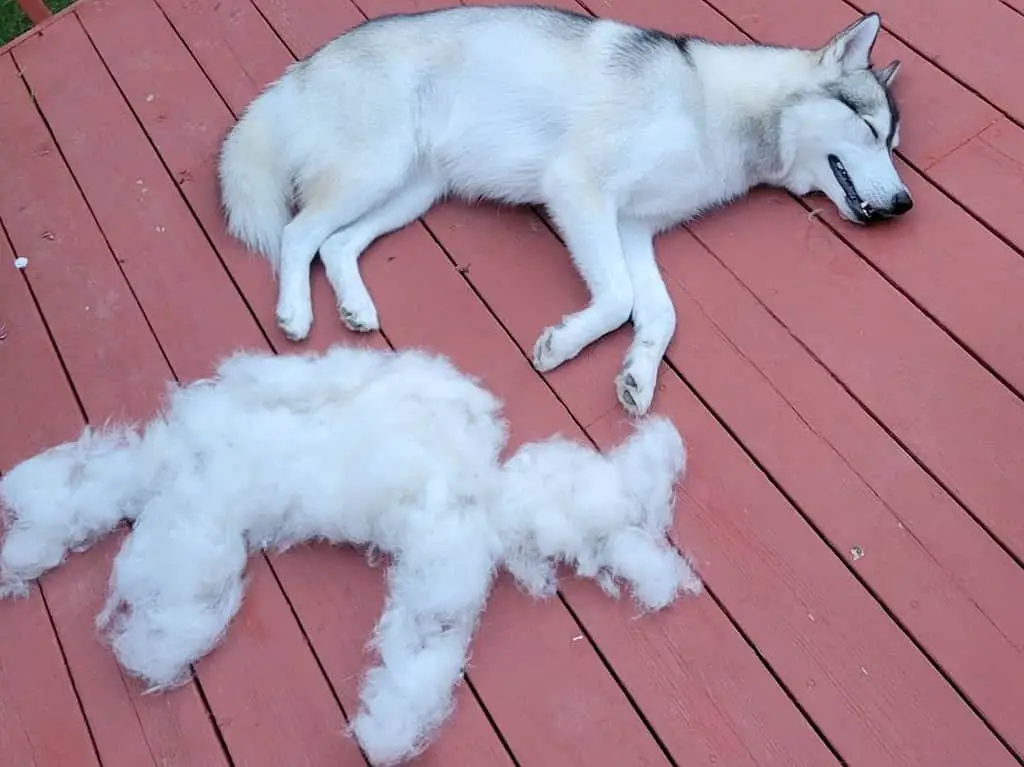
Why Dog Shedding Is A Problem
Shedding is a natural occurrence for dogs; however, it can be accompanied by specific issues that present difficulties. One significant issue is the growth of excess fur within the home environment, causing germs to spread more rapidly and making additional cleaning measures necessary. The presence of dog hair in almost any enclosed area, such as furniture pieces or clothes, is also difficult to avoid no matter how much effort has been put into vacuuming and sweeping; Even the air itself seems to carry drifting hairs. These consequences make proper shedding management essential in maintaining home cleanliness and personal hygiene.
Individuals with asthma or other respiratory issues must take dog shedding into consideration. Dog hair contains allergens, which may heighten symptoms, making breathing hard and potentially leading to severe reactions. This situation is notably more precarious in households where shedding dogs live with young kids or elderly family members. They are especially prone to allergic reactions due to their underdeveloped or weakened immune systems.
Dog shedding presents various problems beyond the home, as this phenomenon can additionally lead to issues outdoors. Dog hair may accumulate in private gardens, stick to foliage, and clog up patio furniture. Moreover, the potential environmental consequences cannot be overlooked; an abundance of fur can be ingested by wildlife or contaminate nearby water sources. Lastly, many dog owners must also worry about guests leaving with trace amounts of pet fur on their clothing when visiting a home that was thoroughly cleaned beforehand.
Dog shedding is a demanding responsibility for owners and should not be overlooked. Implementing investment in grooming services, regular brushing, vacuuming, and other necessary tasks can drastically reduce the impact of shedding. This activity may challenge those with limited resources or busy schedules, particularly for breeds with heavy coats that tend to shed more than others.
The Husky As A Double-Coated Dog
One of the key distinguishing features of the Husky is its double coat. This protective layer comprises a dense, insulating undercoat and a strong, weather-resistant outer coat. With this covering, these dogs can survive in drastically cold temperatures due to their thermal insulation capabilities trapping heat around its body. Thus, enabling them to live through frigid conditions with ease.
The double layer of a Husky’s coat benefits its health in warm weather, as it acts as a natural barrier against UV rays. Furthermore, this dual layer facilitates ventilation and disperses heat away from the pup, helping them regulate their temperature.
Despite its many desirable qualities, the Husky’s double coat requires considerable upkeep. During seasonal changes, these dogs shed profusely and thus require frequent brushing to prevent matting and maintain a healthy coat.
Understanding Dog Shedding: What Causes It?
Shedding is typically the result of a dog’s natural hair growth cycle, which functions similarly to a human’s. The process begins with active follicle production, followed by a resting stage when the hairs reach specific lengths. As they enter their final cycle, they detach from their follicles and are shed as part of the normal shedding process.
Environmental conditions can affect shedding. Variations in temperature and light exposure, according to the season, influence a dog’s normal growth cycle of their hair, which may result in them shedding their old coat to make room for one more suitable for the current climate. Furthermore, indoor air control systems such as heaters or air conditioners may interfere with the natural shedding pattern of dogs, resulting in persistent shedding all year round.
The quality of a dog’s coat and degree of shedding heavily depends on proper nutrition. Insufficient dietary intake of the right nutrients will result in an unappealing coat and unnecessary hair loss. Suppose a dog does not receive adequate nutrients and essential vitamins and omega-3 fatty acids through their diet. In that case, it can lead to the same effects as underlying health issues – such as allergies, hormonal imbalances, or parasites – and result in excessive shedding.
Similarly, grooming habits affect shedding. Routine grooming by brushing can help eliminate dead and loose hair, thereby reducing the amount of hair accumulating on furniture or clothing. Skipping out on grooming may cause substantial shedding as a consequence of all the accumulated fur that would’ve been otherwise taken out during brushing otherwise.
Ways To Stop Husky Shedding

1. Proper Grooming Techniques: Brushing, Bathing, and Trimming
Grooming is an integral aspect of caring for a Husky, which involves regularly using a slicker brush and de-shedding tool to remove excess fur, prevent matting, and disperse natural oils across their coats. Additionally, during their shedding season, when more frequent grooming is necessary, daily brushing is highly required.
Careful consideration should be taken when bathing a Husky, as frequent baths can strip their coats of its natural oils. A mild dog shampoo created for breeds with a double coat should be used for optimal results. Before washing, thoroughly brushing their hair must take place to eliminate any tangles or loose hair. Due to the self-cleaning qualities of this breed, baths are only necessary once a week unless they have gotten dirty or started to smell unpleasant. Overbathing can generate adverse effects such as dry and irritated skin; thus, it is best avoided.
Likewise, taking on the task of trimming a Husky’s fur should be treated cautiously and solely done when needed. Huskies possess a dense coat that naturally protects their skin and therefore doesn’t necessitate regular maintenance. However, inspection of the paw pads and the nails is essential to avoid them becoming too long, as such can create pain for them. Trimming around their paws may help improve traction while inhibiting the accumulation of dirt between toes. Maintenance of their nails through frequent trimmings is crucial to sustaining paw health, maintaining good posture, and eliminating discomfort.
When grooming a Husky, it is essential to use specialized nail clippers designed for dogs and exercise caution during the process. Avoid cutting too close to the nail quick, as this contains sensitive nerve endings that may cause discomfort or bleeding. If inexperienced with trimming a dog’s nails, seek advice from an experienced groomer or veterinarian to ensure safe procedure handling.
2. Quality Diet and Supplements: Omega-3 Fatty Acids and Biotin
Eating a nutritious diet and incorporating suitable dietary supplements can be incredibly beneficial to reducing the amount of shedding in Huskies. Notable nutrients that should be considered include omega-3 fatty acids and biotin.
Omega-3 fatty acids have documented positive impacts on health, such as encouraging a glossy coat and limiting fur loss in canines. These fats are available via fish oil and plant sources like flaxseed oil. The introduction of abundant omega-3 foods or supplements into their diet likely results in healthy skin and hair, with decreased shedding being a potential outcome. Omega-3 fatty acids feed the hair follicles, reinforce the exterior hair structure, and reduce inflammation under the outer layer of the skin.
Biotin supplement, medically referred to as vitamin B7 supplement, is one of the effective ways to stop Husky shedding. Specifically, biotin aids in metabolizing fatty acids and the growth of nails and hair. Further, it helps strengthen the hair shaft and stimulates healthier skin development, regulating excessive shedding. Introducing biotin supplements into a Husky’s diet can better their overall coat health.
When incorporating omega-3 fatty acids and biotin into a Husky’s dietary regimen, it is possible that shedding could be limited; however, results are not guaranteed to be uniform. A veterinarian should always be consulted before introducing supplements to confirm the appropriate dosage and compatibility with your pup.
3. Environment Management: Humidity Control and Air Purifiers
Monitor the humidity to prevent skin dryness and dandruff, which intensify a husky’s shedding. Ensuring optimal humidity through humidifiers works to combat dry conditions and reduce irritation on a husky’s skin. Consequently, this yields better coat maintenance as the dog will experience less frequent shedding.
Additionally, Huskies often suffer from excessive shedding due to pollen, dust, and other allergens irritating skin. Air purifiers effectively filter these particles out of the air to create a cleaner environment for the Husky. This will help reduce skin sensitivity and thus decrease intense shedding patterns.
Huskies and their owners can benefit from using humidity control and air purification systems. Careful monitoring and adjustments should be performed regularly to ensure that the humidity level in the home falls within normal ranges, while selecting a high-quality air purifier helps maintain a clean environment. While these measures may lessen shedding, it is essential to remember that this is an unavoidable trait of Huskies, requiring frequent grooming procedures.
4. Regular Exercise: Reduce Hair Loss and Anxiety
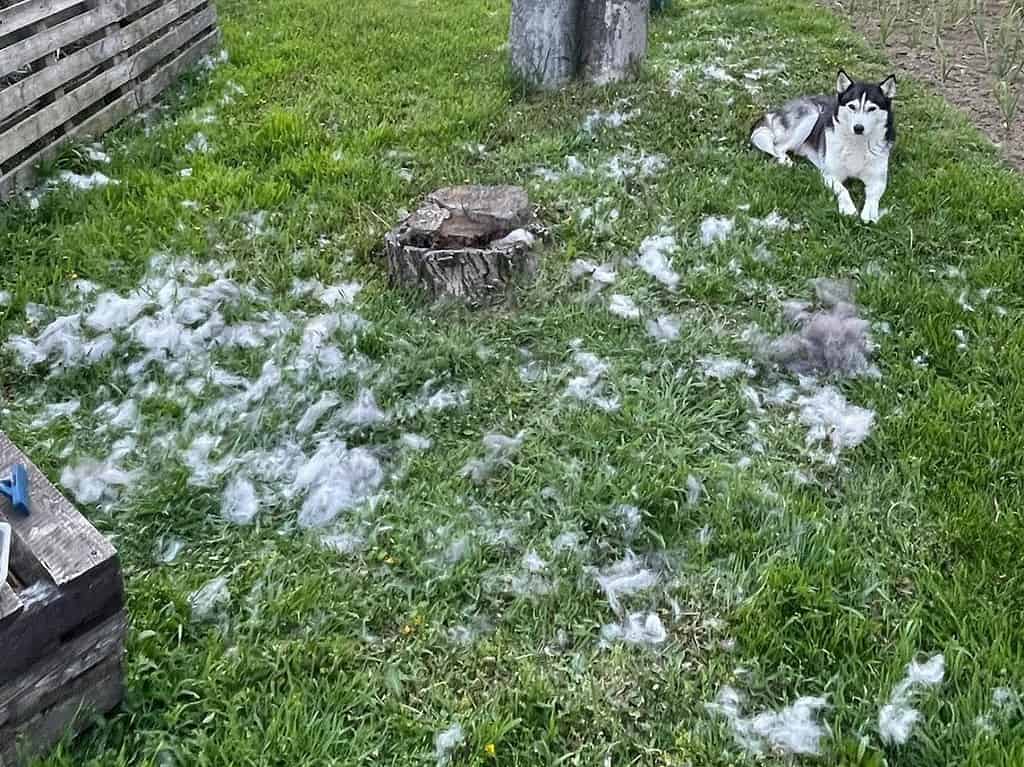
Exercise constitutes an essential factor in maintaining physical and mental health, even in breeds such as Huskies, known for their constant tendency to shed. Reducing anxiety levels through regular physical activity may even contribute to minimizing hair loss due to the similarities between humans and dogs. To ensure a healthy physique and emotional state, it is paramount that Huskies receive sufficient exercise regularly to alleviate existing anxiety which could otherwise lead to further shedding.
Being an active and energetic breed, Huskies require regular physical activity to achieve a balanced mental state. Exercise assists such endeavors by providing an outlet for energy expenditure and initiating endorphin (feel-good hormone) production. This occurrence has been proven to help mitigate stress and anxiety levels associated with the canine breed – subsequently decreasing hair loss caused by prolonged sentiments of fear or worry.
In addition to these benefits, exercise also positively impacts the coat of a Husky. Increased blood circulation brings essential nutrients and oxygen to hair follicles, encouraging optimal growth and decreasing shedding. Additionally, regular exercise helps maintain the skin in a healthy condition through improved elasticity and moisture balance.
5. Professional Grooming Services: Helpful Options for Busy Owners
Busy Husky owners struggling to manage the generous amounts of shedding can seek help from professional groomers. The excess hair can demand intensive grooming efforts from the owner, and groomers can help eliminate this burden. This invaluable resource helps keep your home clean and allows you more time for other responsibilities.
Groomers possess the necessary qualifications and equipment required to manage Husky shedding successfully. Regular brushing sessions can be easily executed using specialized brushes to extract loose hair efficiently. Furthermore, groomers can provide de-shedding treatments to limit considerable fur loss associated with the Husky’s undercoat. Not only do these treatments expedite this condition, but they also help sustain a healthy coat.
In addition, experienced groomers possess the expertise to detect any potential skin ailments or medical issues that may be present in Huskies, thus providing an opportunity for prompt action to be taken. Pet owners can save energy and time while ensuring their animal friends remain hygienic and comfortable by delegating the task of grooming their dogs to qualified experts.
6. Natural Remedies
Coconut oil is well-regarded for its moisturizing qualities, which makes it an effective home remedy when managing excessive hair loss or controlling shedding. Applying a small amount of coconut oil to the skin and fur during regular massage sessions can effectively reduce shedding while providing moisturizing benefits for optimal coat health. Furthermore, its natural lubricant qualities simplify brushing without compromising home cleanliness.
7. Hydration For Healthy Skin and Coat
Hydration is vital for skin health; optimal hydration produces more resilient and less irritated skin. When a Husky’s skin suffers from dehydration, it can become itchy and be at risk of various dermatological issues. Furthermore, dehydrated skin may cause excessive shedding due to its struggle to retain natural oils and preserve a healthy balance. Adequate hydration is essential to fortify the skin’s barrier function, which prevents water loss.
A Husky’s proper hydration levels aids in developing a healthy coat. Without ample consumption of fluids, skin, and hair can become dry and brittle, potentially leading to breakage or excessive shedding. Additionally, regular hydration encourages the production of natural oils that safeguard against damage while nourishing growing hair follicles. This can leave coats glossy, flexible, and damage-resistant.
But adequate hydration in Huskies requires more than access to water; providing a balanced diet is also essential. Moist and wet food is particularly beneficial as well. Moreover, clean drinking water must be consistently given to preserve the health of this breed with high energy levels.
8. Shedding Control Products
The primary benefit of using shedding control products on Huskies is that they can drastically reduce the amount of fur they shed. Utilizing a specialized shampoo for Huskies formulated to remove loose hair from their coats will help promote healthier skin and coats, lessening the potential for excessive shedding. In addition, utilizing a conditioner formulated especially for shedding control allows one to nourish their dog’s coat while minimizing breakage, which should result in reduced overall shedding.
As mentioned, effective Husky shedding control requires brushing with specialized tools, such as slicker brushes or de-shedding tools. These brushes can penetrate the thick fur, removing any loose hairs. Besides controlling the amount of shed fur, regular brushing also helps maintain coat quality by spreading natural oils and reducing tangles. As a result, this process will significantly diminish the amount of hair accumulated on the furniture.
Unmanaged or excessive shedding may lead to dog hair getting scattered all over the house, thus creating a particularly troublesome environment for those with allergies or asthma. Owners can use such products to proactively manage and reduce the amount of loose hair in their surroundings, leading to tidier spaces and lessened risks for allergic reactions.
Not only can the use of products that control shedding benefit Huskies practically, but their well-being is also impacted. Uncontrolled shedding can cause itchiness and irritation in dogs, leading to discomfort and decreased happiness. By employing tools that encourage healthy skin and coats, owners of Huskies will be able to provide a sense of comfort for their pet while maintaining its overall health.
9. Regular Veterinary Checkups
A trained professional can evaluate the general well-being and status of the Husky during a veterinary exam. Different skin and fur areas can be examined for any indications of allergies, hypersensitivities, or medical issues that could lead to extreme shedding. By quickly recognizing and tending to these problems, the vet may put forward a treatment plan or preventive methods that help decrease shedding.
But that’s not all. Strict adherence to a veterinary schedule is necessary for appropriate vaccinations and parasite prevention. Sadly, Huskies are quite susceptible to various health issues related to external parasites such as fleas, mites, or tick-borne diseases; skin irritation caused by these organisms can potentially lead to shedding if not adequately treated.
By carefully following a veterinarian’s medical instructions, your dog remains healthy and comfortable.
In addition, routine dog examinations provide an opportunity to consider how lifestyle decisions can influence the amount of shedding. The veterinarian will ask questions concerning the living circumstances, diet regimen, activity levels, and any other recent shifts that may have impacted their Husky’s coat health. With a comprehensive evaluation of the dog’s environment and lifestyle, the veterinarian can suggest strategies to help reduce shedding, such as having a consistent nutrition plan, guaranteeing enough hydration, and providing adequate grooming procedures – all of which are discussed above.
To conclude, it is essential to consult a veterinarian in cases where a Husky presents with substantial shedding. A thorough examination and potential diagnostic tests will confirm if inadequate nutrition, allergies, infections, or other causes trigger the shedding. The right medical care and management can help restore the dog’s coat and general wellness.

